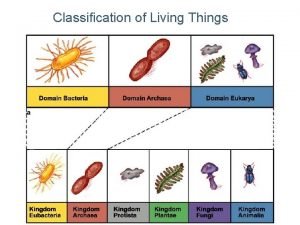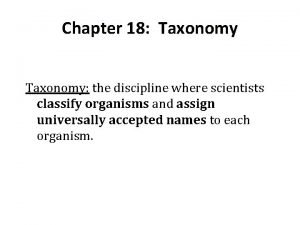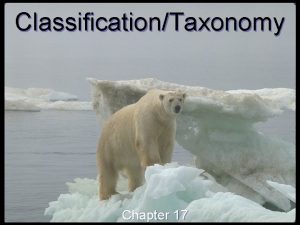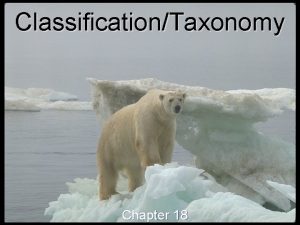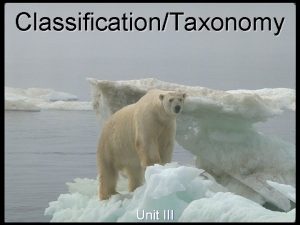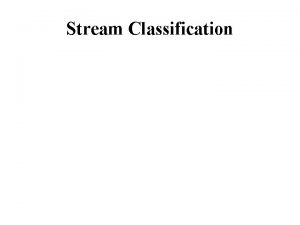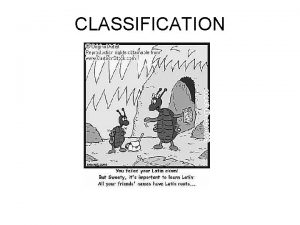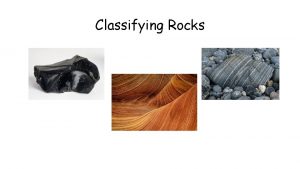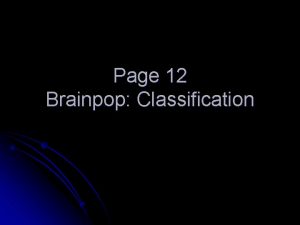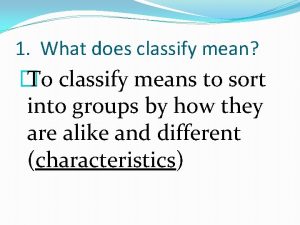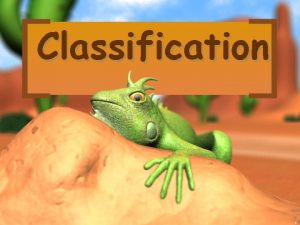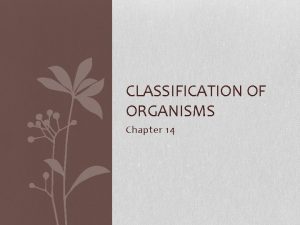ClassificationTaxonomy Chapter 18 Why Classify To study the































- Slides: 31

Classification/Taxonomy Chapter 18

Why Classify? To study the diversity of life, biologists use a classification system to name organisms, group them in a logical manner, and study evolutionary relationships.

Taxonomy Discipline of classifying organisms and assigning each organism a universally accepted name. Defined: In other words, naming things.

Why common names don’t work Common names vary among different languages. Cat Arabic: quttah Czech: kocka French: chat German: katze Japanese: neko Russian: kotchka Spanish: gato

Why common names don’t work Common names vary among different countries. Example: United Kingdom – Buzzard refers to a hawk United States – Buzzard refers to a vulture Red-tailed Hawk Honey Buzzard Turkey Vulture

Why common names don’t work Many species have several common names. Sand tiger shark Sand shark Gray nurse shark

Why common names don’t work Same common name used for different species Dolphin Mahi mahi Dolphin Turciops truncatus

First Attempt to Classify Aristole (Greek Philosopher) * * About 300 BC Classified based on method of reproduction Used the words like “genera” and “species” Grouped animals between those with blood and those without blood * He had many errors in his classification system, but it was used until the 1700 s

Carolus Linnaeus l (1707 – 1778) l Created the system of naming we use today. l In taxonomy, a group or level of organization is called a taxonomic category or taxon.

Binomial Nomenclature l “Bi” means 2 l “nomial” means naming l Nomenclature means “the system of” Defined: In Binomial Nomenclature, each species is assigned a two-part scientific name. (genus & species)

Example of Binomial Nomenclature l Polar Bear is Ursus maritimus l Ursus: genus Ursus contains 5 other kinds of bears l maritimus: species The Latin word, maritimus, refers to the sea. Polar bears often live on pack ice that floats in the sea.

Here We Go… Polar Bear *Do NOT have to write* Species: maritimus Genus: Ursus Family: Ursidae Order: Carnivora Class: Mammalia Phylum: Chordata Kingdom: Animilia What do these mean? . . . lets see

What they mean *Do NOT have to write* Species: maritimus (lives in marine environment) Genus: Ursus (kind of bear) Family: Ursidae (larger category of bears) Order: Carnivora (meat-eating animals) Class: Mammalia (warm-blooded, hair, & milk) Phylum: Chordata (vertebrates) Kingdom: Animilia (there are 6 kingdoms)

How to remember: Da King Phillip Came Over For Green Salad Domain Kingdom Phylum Class Order Family Genus Species

Phylum Chordata Class Mammalia Order Carnivora Family Ursidae Genus Ursus Species maritimus

Rules of the Game Uniqueness: Every name has to be unique. Universality: Zoologists have adopted, by International Code of Zoological Nomenclature, a set of rules for naming animals. A single language is to be used on a worldwide basis. All animals are given a generic name (common name) and specific name in Latin &/or Greek (scientific name). These names are in italics when TYPED or are underlined when HAND WRITTEN. Human: Homo sapiens Lion: Panthera leo

Taxonomy Video

Genus species If these three species belong to the same genus, they are descended from a common ancestor. Felis domestica Felis negripes Domestic Cat Felis negripes Black Footed Cat Felis margarita Sand cat`

A Problem with Traditional Classification l Traditional classification systems relied on body structure comparisons only (not DNA) l Due to convergent evolution, organisms that are quite different from each other evolve similar body structures. Convergent Evolution: Process by which unrelated organisms independently evolve similarities when adapting to similar environments. Sugar Glider… Live in Australia Look similar, but totally unrelated! Flying Squirrel… Live in the US (GA)

Another Problem with Traditional Classification Example: The Crab, The barnacle, & The limpet • The barnacle and the limpet have similarly shaped shells & look alike • The crab has a very different body form • Based on anatomy, the barnacle & limpet could be classified together and the crab in a different group.

Related This incorrect because crabs and barnacles are actually related

Modern Principles of Classification l Modern classification system has its roots in the system of Linnaeus l Modern classification has been revised to reflect Darwinian Principle of common descent l Most recently, molecular systematics (DNA) has driven the most recent revisions in classification

Crustaceans Gastropods Molted Exoskeleton Segmentation Free swimming Larva Even though they do not look a like, crabs & barnacles are actually related

Evolutionary Classification l Biologists now group organisms into categories that represent lines of evolutionary descent, not just physical similarities Evolution Classification: Is the strategy of grouping organisms together based on their evolutionary history.

Classification Using Cladograms Cladogram: A diagram that shows the evolutionary relationships among a group of organisms.

Crustaceans Gastropods Molted Exoskeleton Segmentation Free swimming Larva Using Cladograms, you can see that crabs and barnacles share similar characteristics because they both molt & are segmented

Crustaceans Gastropods Molted Exoskeleton Segmentation Free swimming Larva You can also see that ALL have a free swimming larva stage

The Three-Domain System l In 1990, a new taxonomic level called Domain was introduced and changed how bacteria were classified. l Domain Archaea l Domain Bacteria Both are Bacteria l Domain Eukarya Everything else (Except viruses) l There are 6 Kingdoms total: 1. Eubacteria 2. Archaebacteria 3. Protista 4. Fungi 5. Plantae 6. Animalia

6 Kingdoms Eubacteria Prokaryote Autotroph or heterotroph Archaebacteria Prokaryote Autotroph or heterotroph “Ancient Bacteria” Most common bacteria E. ecoli Protista Fungi Plantae Animalia Eukaryote Autotroph Heterotroph Autotroph/ Heterotroph heterotroph Includes Algae Live in very hot places Don’t belong in other euk Pyrococcus furiosus Paramecium No cell wall Release enzymes to digest food Cell walls & Chloroplasts H. coccinea Fern frod No chloroplasts Multicellular Homo sapiens

Phyla To Know Porifera: Sponges Cnidaria: Jellyfish, Sea Anemones, Corals Echinodermata: Sea Urchin, Starfish, Sand Dollars Mollusca: Snails, Clams, Octopus Arthropoda: Insects, Crustaceans, Spiders Chordata: Vertebrates

The End.
 Pictures
Pictures Dont ask
Dont ask Why do we classify living things
Why do we classify living things The scientific discipline of classifying organisms
The scientific discipline of classifying organisms Why isn't it a good idea to classify matter by its phases
Why isn't it a good idea to classify matter by its phases Why do biologists classify
Why do biologists classify Why do scientists classify living things?
Why do scientists classify living things? Financial markets and institutions chapter 1
Financial markets and institutions chapter 1 Hình ảnh bộ gõ cơ thể búng tay
Hình ảnh bộ gõ cơ thể búng tay Frameset trong html5
Frameset trong html5 Bổ thể
Bổ thể Tỉ lệ cơ thể trẻ em
Tỉ lệ cơ thể trẻ em Chó sói
Chó sói Glasgow thang điểm
Glasgow thang điểm Chúa yêu trần thế alleluia
Chúa yêu trần thế alleluia Các môn thể thao bắt đầu bằng tiếng chạy
Các môn thể thao bắt đầu bằng tiếng chạy Thế nào là hệ số cao nhất
Thế nào là hệ số cao nhất Các châu lục và đại dương trên thế giới
Các châu lục và đại dương trên thế giới Công của trọng lực
Công của trọng lực Trời xanh đây là của chúng ta thể thơ
Trời xanh đây là của chúng ta thể thơ Mật thư anh em như thể tay chân
Mật thư anh em như thể tay chân 101012 bằng
101012 bằng Phản ứng thế ankan
Phản ứng thế ankan Các châu lục và đại dương trên thế giới
Các châu lục và đại dương trên thế giới Thể thơ truyền thống
Thể thơ truyền thống Quá trình desamine hóa có thể tạo ra
Quá trình desamine hóa có thể tạo ra Một số thể thơ truyền thống
Một số thể thơ truyền thống Cái miệng bé xinh thế chỉ nói điều hay thôi
Cái miệng bé xinh thế chỉ nói điều hay thôi Vẽ hình chiếu vuông góc của vật thể sau
Vẽ hình chiếu vuông góc của vật thể sau Biện pháp chống mỏi cơ
Biện pháp chống mỏi cơ đặc điểm cơ thể của người tối cổ
đặc điểm cơ thể của người tối cổ Ví dụ về giọng cùng tên
Ví dụ về giọng cùng tên


